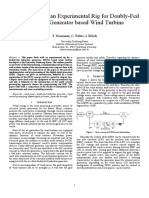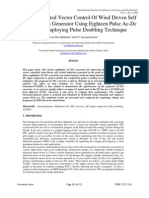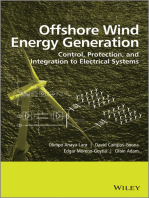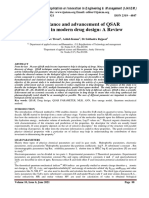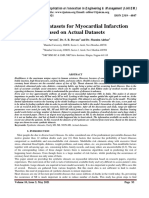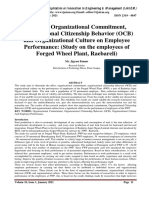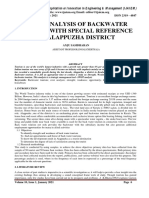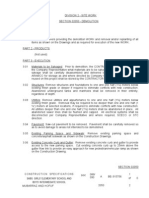0 ratings0% found this document useful (0 votes)
40 viewsControlling of DFIG Wind Turbine Under Unbalanced Grid Fault Condition
Controlling of DFIG Wind Turbine Under Unbalanced Grid Fault Condition
This document discusses control strategies for a doubly fed induction generator (DFIG) used in wind turbines under unbalanced grid fault conditions. It presents a control method that uses additional compensation controllers to balance stator currents and eliminate torque and reactive power pulsations caused by an unbalanced grid. The control design section describes the controllers implemented, including inner current controllers, a speed controller, reactive power controller, and compensation controllers with high gain at the disturbance frequency to reduce negative impacts of an unbalanced grid. Simulation results show the control strategy is able to compensate for issues caused by an unbalanced grid voltage.
Copyright:
© All Rights Reserved
Available Formats
Download as PDF, TXT or read online from Scribd
Controlling of DFIG Wind Turbine Under Unbalanced Grid Fault Condition
Controlling of DFIG Wind Turbine Under Unbalanced Grid Fault Condition
0 ratings0% found this document useful (0 votes)
40 views5 pagesThis document discusses control strategies for a doubly fed induction generator (DFIG) used in wind turbines under unbalanced grid fault conditions. It presents a control method that uses additional compensation controllers to balance stator currents and eliminate torque and reactive power pulsations caused by an unbalanced grid. The control design section describes the controllers implemented, including inner current controllers, a speed controller, reactive power controller, and compensation controllers with high gain at the disturbance frequency to reduce negative impacts of an unbalanced grid. Simulation results show the control strategy is able to compensate for issues caused by an unbalanced grid voltage.
Original Title
IJAIEM-2014-05-29-097
Copyright
© © All Rights Reserved
Available Formats
PDF, TXT or read online from Scribd
Share this document
Did you find this document useful?
Is this content inappropriate?
This document discusses control strategies for a doubly fed induction generator (DFIG) used in wind turbines under unbalanced grid fault conditions. It presents a control method that uses additional compensation controllers to balance stator currents and eliminate torque and reactive power pulsations caused by an unbalanced grid. The control design section describes the controllers implemented, including inner current controllers, a speed controller, reactive power controller, and compensation controllers with high gain at the disturbance frequency to reduce negative impacts of an unbalanced grid. Simulation results show the control strategy is able to compensate for issues caused by an unbalanced grid voltage.
Copyright:
© All Rights Reserved
Available Formats
Download as PDF, TXT or read online from Scribd
Download as pdf or txt
0 ratings0% found this document useful (0 votes)
40 views5 pagesControlling of DFIG Wind Turbine Under Unbalanced Grid Fault Condition
Controlling of DFIG Wind Turbine Under Unbalanced Grid Fault Condition
This document discusses control strategies for a doubly fed induction generator (DFIG) used in wind turbines under unbalanced grid fault conditions. It presents a control method that uses additional compensation controllers to balance stator currents and eliminate torque and reactive power pulsations caused by an unbalanced grid. The control design section describes the controllers implemented, including inner current controllers, a speed controller, reactive power controller, and compensation controllers with high gain at the disturbance frequency to reduce negative impacts of an unbalanced grid. Simulation results show the control strategy is able to compensate for issues caused by an unbalanced grid voltage.
Copyright:
© All Rights Reserved
Available Formats
Download as PDF, TXT or read online from Scribd
Download as pdf or txt
You are on page 1of 5
International Journal of Application or Innovation in Engineering& Management (IJAIEM)
Web Site: www.ijaiem.org Email: editor@ijaiem.org
Volume 3, Issue 5, May 2014 ISSN 2319 - 4847
Volume 3, Issue 5, May 2014 Page 288
NOMENCLATURE
vsd, vsq Stator d and q winding voltage.
isd, isq Stator d and q winding current.
vrd, vrq Rotor d and q winding voltage.
ird, irq Rotor d and q winding current.
sd, sq Stator d and q winding flux linkage.
rd, rq Rotor d and q winding flux linkage.
T Generator torque.
Qs Stator reactive power.
Lm Generator magnetizing inductance.
Ls, Lr Stator and rotor per phase winding inductance.
Lls, Llr Stator and rotor per phase leakage inductance.
Rs,Rr Stator and rotor per phase winding resistance.
p Number of generator poles.
n Rotor/stator turns ratio.
J System moment of inertia.
B System frictional constant.
d dq-axes frame rotational speed with respect to the stator.
dA dq-axes frame rotational speed with respect to the rotor.
qsyn Synchronous rotational speed (50 Hz).
qmech Rotor mechanical speed.
ABSTRACT
A wind electrical generation system is the most cost competitive of all the environmentally clean and safe renewable energy
sources in world. In induction wind generators, unbalanced three-phase stator voltages cause a number of problems, such as
unbalanced currents, reactive power pulsations, and stress on the mechanical components. Sometimes, induction wind generators
are switched out of the network, beyond a certain amount of unbalance. This can further weaken the grid and affects the overall
system. In this analysis doubly fed induction generator (DFIG), is used to control the rotor currents. The controlling of rotor
currents allows the controlling of reactive power and variable speed operation, so it can operate at maximum efficiency over a
wide range of wind speeds. The controlling of DFIG, variable speed wind turbine under network fault is studied using simulation
developed in MATLAB/SIMULINK. This paper presents a DFIG control strategy that enhances the standard speed and reactive
power control with controllers that can compensate for the problems caused by an unbalanced grid .This strategy involves
balancing of the stator currents and eliminating torque and reactive power pulsations.
Keywords: DFIG, reactive power control, torque control, variable speed drive, wind energy.
1. INTRODUCTION
The global electrical energy consumption is rising and there is steady increase of the demand on power generation. So
in addition to conventional power generation units a large no. of renewable energy units is being integrated into the
power system. A wind electrical generation system is the most cost clean and safe renewable energy sources in world.
The recent evolution of power semiconductors and variable frequency drive technology has aided the acceptance of
variable speed generation systems. Both fixed-speed squirrel-cage induction generator and variable speed doubly fed
induction generator are used in wind turbine generation technology. A special type of induction generator, called a doubly
fed induction generator (DFIG), is used extensively for high-power wind applications. A double fed induction generator is
a standard, wound rotor induction machine with its stator windings is directly connected to grid and its rotor windings is
connected to the grid through an AC/DC/AC converter. AC/DC converter connected to rotor winding is called rotor side
converter and another DC/AC is grid side converter. DFIGs ability to control rotor currents allows for reactive power
control and variable speed operation, so it can operate at maximum efficiency over a wide range of wind speeds. In this
analysis we use a control method of DFIG to compensate the problems caused by a unbalanced grid. This will allow
Controlling Of DFIG Wind Turbine Under
Unbalanced Grid Fault Condition
Preeti Yadav
1
, Swati Maurya
2
, Divya Garg
3
and Yashaswini Singh
4
Galgotias University, M.Tech (PED), GautamBuddh Nagar, Yamuna Expressway, Greater Noida, U.P 203201
International Journal of Application or Innovation in Engineering& Management (IJAIEM)
Web Site: www.ijaiem.org Email: editor@ijaiem.org
Volume 3, Issue 5, May 2014 ISSN 2319 - 4847
Volume 3, Issue 5, May 2014 Page 289
DFIGs to stay connected to the grid under conditions in which they would normally be disconnected for their own
protection. Rotor side converter control is only considered.
Figure 1 Doubly Fed Induction Generator
2. CONTROLLER DESIGN
For the proposed control, hysteresis control is used. The control structure is shown in Figs. 2 and 3. The control topology
is standard except for the addition of the Cd,comp and Cq,comp controllers, which supplement the d- and q-axis rotor
voltage. These feedback controllers shown gives the loops a very high gain at the known disturbance frequency (100 Hz).
Further, the controllers compensate the torque and reactive power pulsations that arise when the stator voltage is
unbalanced. Reducing the reactive power pulsation dramatically improves the unbalance of stator current.
Figure 2 d-Axis control topology
Figure 3 q-Axis control topology
For symmetrical components, compensation for torque and reactive power pulsations is analogous to a controller injecting
a negative sequence into the rotor circuit in such a manner as to compensate for the negative sequence in the stator
circuit. It results into reduction of torque pulsations, reactive power pulsations, and stator-current unbalance under
unbalanced grid voltage conditions.
2.1 Design of Cird and Cirq
The inner loop ird and irq current controllers, Cird and Cirq,were designed using linearized state equations. This is done
by substituting the generator flux linkages (1) through (3) into the generator voltage equation (4) [6]. After obtaining the
generator currents as a state equation relating the voltage and current in the dq frame, as shown in (5). From this form,
the transfer functions relating current to voltage are easily obtained, assuming dA is constant.
International Journal of Application or Innovation in Engineering& Management (IJAIEM)
Web Site: www.ijaiem.org Email: editor@ijaiem.org
Volume 3, Issue 5, May 2014 ISSN 2319 - 4847
Volume 3, Issue 5, May 2014 Page 290
Fromthe linearized state equations (5), ird/vrd(s) and irq/vrq(s) are determined.
2.2 Design of Cmech
For the design of speed controller, the mech/ird(s) transfer function must be determined.
Since imq is large negative and imd is very small. Therefore, the torque can be approximated as
A fast speed loop will respond more quickly to changes in the load and a slow speed loop will allow the generator
to accelerate or decelerate as the wind
changes.
Figure 4 ird loop with disturbance rejection controller
2.3 Design of CQs
The reactive power outer loop is designed by relating stator reactive power Qs to irq.
International Journal of Application or Innovation in Engineering& Management (IJAIEM)
Web Site: www.ijaiem.org Email: editor@ijaiem.org
Volume 3, Issue 5, May 2014 ISSN 2319 - 4847
Volume 3, Issue 5, May 2014 Page 291
The magnetizing current imq can be approximated as constant. Equation (13), then, can be written as
A PLL controller is used.
2.4 Design of Unbalance Compensation Controllers Cd,comp and Cq,comp
The Cd,comp and Cq,comp controllers shown in Figs. 2 and 3. The Cd,comp and Cq,comp controllers are designed to
have a large gain at the known disturbance frequency but also to have a negligible effect at all other frequencies. This is
done by using a high-Q, second order resonant filter. Also removing the second harmonic from ird and irq will not
completely remove the second harmonic from the torque and reactive power, although it can reduce it.
3. SIMULATION RESULTS
(a)
(b)
(C)
(D)
(E)
(a) Stator Voltage
(b) Stator Current
(c) Grid voltage
(d) Capicitor voltage
(e) Modulation index
International Journal of Application or Innovation in Engineering& Management (IJAIEM)
Web Site: www.ijaiem.org Email: editor@ijaiem.org
Volume 3, Issue 5, May 2014 ISSN 2319 - 4847
Volume 3, Issue 5, May 2014 Page 292
4. CONCLUSION
A control methodology for DFIG wind turbine under unbalanced grid fault condition is presented. Controlling helps to
compensate the torque pulsations, reactive power pulsations, and unbalanced stator current that normally occur when
stator voltage is unbalanced. This improves the quality of the power fed into the grid by reducing the wear on the
mechanical components.
References
[1] Ned Mohan, Ted K. A. Brekken Control of a Doubly Fed Induction Wind Generator Under Unbalanced Grid
Voltage Conditions IEEE Transaction Energy conversion, vol.no22. 1, march 2007 page 129-135.
[2] Y. Zhou, P. Bauer Control of DFIG under Unsymmetrical Voltage dips Power Electronics Specialists Conference,
2007. PESC 2007. IEEE 17-21 June 2007 Page(s):933 938 .
[3] A. Beugniez, T. Ghennam Centralized supervision of reactive power generation for a wind farm Power Electronics
& Application European conference on 2-5 sep 2007. On page(s): 1-10 ISBN: 978-92 75815-10-8.
[4] Jesus Lopez, Pabolo Sanchis Control of DFIG under Symmetrical Voltage dips IEEE july 2008. Page(s) 2456-
2462.
[5] Rubn Penaa, Roberto Cardenasb,, Enrique Escobarb, Jon Clarec, Pat Wheelerc Control strategy for a Doubly-Fed
Induction Generator feeding an unbalanced grid or stand-alone load Electric Power Systems Research (2009) 355
364.vol.79 .
[6] Johan Morren, Sjoerd W. H. de Haan, Ridethrough of Wind Turbines with Doubly-Fed Induction Generator During
a Voltage Dip IEEE transaction on energy conversion june, 2005 pages 435-441 vol. 20.
[7] Sae-Kok, W.,Grant, D.M. Open Switch Fault Diagnosis for a Doubly-Fed Induction Generator Power Electronics
and Drive Systems, IEEE 2007. PEDS '07. 7th International Conference on 27-30 Nov. 2007 Page(s):131 138 .
[8] L. Dusonchet, F. Massaro and E. Telaretti Transient stability simulation of a fixed speed wind turbine by
Matlab/Simulink .
[9] Zhixin Miao, Lingling Fan the art of modeling and simulation of induction generator in wind generation
application simulation modling practice and theory 16 (2008) 1239-1253, science direct.
[10] Ruben Pena , Roberto Cardenas , Jon Clare Control strategy for a DFIG feeding unbalances grid or stand alone
load Electric Power System Research 79(2009) 355-364 science direct.
[11] Wei Qiao; Harley, R.G Improved Control of DFIG Wind Turbines for Operation with Unbalanced Network
Voltages Industry Applications Society Annual Meeting, 2008. IAS '08. IEEE 5-9 Oct. 2008 Page(s):1 7 75 .
You might also like
- Ijeet: International Journal of Electrical Engineering & Technology (Ijeet)Document11 pagesIjeet: International Journal of Electrical Engineering & Technology (Ijeet)IAEME PublicationNo ratings yet
- Effect of AVR and PSS Onpower System TRansient) Wind MSDocument7 pagesEffect of AVR and PSS Onpower System TRansient) Wind MSmaria100% (1)
- Converter Protection Scheme For DoublConverter Doubly-Fed Induction Generators During DisturbancesDocument5 pagesConverter Protection Scheme For DoublConverter Doubly-Fed Induction Generators During DisturbancesijcsnNo ratings yet
- Assessing Behavoir of The Outer Crowbar Protection With The Dfig During Grid FaultDocument12 pagesAssessing Behavoir of The Outer Crowbar Protection With The Dfig During Grid Fault121978ahmedNo ratings yet
- Ozsoy A Novel Current Controller Scheme For Doubly Fed Induction GeneratorsDocument10 pagesOzsoy A Novel Current Controller Scheme For Doubly Fed Induction GeneratorsdankorankoNo ratings yet
- Low Voltage Ride ThroughDocument6 pagesLow Voltage Ride ThroughMona ValikhaniNo ratings yet
- Direct Active and Reactive Power Control of DFIG For Wind Energy GenerationDocument9 pagesDirect Active and Reactive Power Control of DFIG For Wind Energy GenerationElectrical ControlNo ratings yet
- B02120817 PDFDocument10 pagesB02120817 PDFViralBipinchandraRathodNo ratings yet
- An Effective Reference Generation SchemeDocument9 pagesAn Effective Reference Generation SchemeShreyash JoshiNo ratings yet
- IeeeeDocument5 pagesIeeeeHarsha VardhanNo ratings yet
- Analysis of Transient Performance For DFIG Wind Turbines Under The Open Switch FaultsDocument6 pagesAnalysis of Transient Performance For DFIG Wind Turbines Under The Open Switch Faultsalaaa3No ratings yet
- Power Control of DFIG Using Back To Back Converters (PWM Technique)Document5 pagesPower Control of DFIG Using Back To Back Converters (PWM Technique)Heather CarterNo ratings yet
- Sub 15572Document8 pagesSub 15572Heather CarterNo ratings yet
- Electrical Machines and Drives: Report OnDocument18 pagesElectrical Machines and Drives: Report Onkumar mNo ratings yet
- 1 s2.0 S1876610213017268 Main PDFDocument10 pages1 s2.0 S1876610213017268 Main PDFMaroju Santosh KiranNo ratings yet
- Improved Reactive Power Capability With Grid Connected Doublu Fed Induction GeneratorDocument14 pagesImproved Reactive Power Capability With Grid Connected Doublu Fed Induction GeneratorSonaliSrivastavaNo ratings yet
- Improved Reactive Power Capability With Grid Connected Doubly Fed Induction GeneratorDocument14 pagesImproved Reactive Power Capability With Grid Connected Doubly Fed Induction GeneratorUday Wankar100% (2)
- Improved Reactive Power Capability With Grid Connected Doubly Fed Induction GeneratorDocument24 pagesImproved Reactive Power Capability With Grid Connected Doubly Fed Induction GeneratorUday WankarNo ratings yet
- Modeling and Control of A Doubly-Fed Induction Generator (DFIG) Wind Power Generation System For Real-Time SimulationsDocument9 pagesModeling and Control of A Doubly-Fed Induction Generator (DFIG) Wind Power Generation System For Real-Time Simulationsmlsawhney2996No ratings yet
- International Journal of Electrical Power and Energy SystemsDocument16 pagesInternational Journal of Electrical Power and Energy SystemsMøHämêdZãķârįäNo ratings yet
- Limite Reactiva DFIGDocument9 pagesLimite Reactiva DFIGMartin__PringleNo ratings yet
- PPT of Sona CLGDocument24 pagesPPT of Sona CLGRam kumarNo ratings yet
- Doubly-Fed Induction Generator Control For Variable-Speed Wind Power Generation SystemDocument5 pagesDoubly-Fed Induction Generator Control For Variable-Speed Wind Power Generation SystemB Vijay VihariNo ratings yet
- Power Electronics Based FACTS Controller For StabiDocument9 pagesPower Electronics Based FACTS Controller For StabiMuntasir AnwarNo ratings yet
- Harmonic Mitigation in Doubly Fed Induction Generator For Wind Conversion Systems by Using Integrated Active Filter CapabilitiesDocument8 pagesHarmonic Mitigation in Doubly Fed Induction Generator For Wind Conversion Systems by Using Integrated Active Filter CapabilitiesijcctsNo ratings yet
- Modeling and Simulation of Dfig To Grid Connected Wind Power Generation Using MatlabDocument12 pagesModeling and Simulation of Dfig To Grid Connected Wind Power Generation Using MatlabIAEME PublicationNo ratings yet
- Short Circuit Currents of DFIG Based Wind Turbines - Bhatia2016Document6 pagesShort Circuit Currents of DFIG Based Wind Turbines - Bhatia2016zeljko_popovic9740No ratings yet
- Ieee 2Document6 pagesIeee 2Harsha VardhanNo ratings yet
- Neumann 2010Document6 pagesNeumann 2010هبهوب محمدNo ratings yet
- Intensifications Reactive Power During of Asymmetric Network Outages in Dual-Stator Winding GeneratorsDocument8 pagesIntensifications Reactive Power During of Asymmetric Network Outages in Dual-Stator Winding GeneratorsInternational Journal of Power Electronics and Drive SystemsNo ratings yet
- Modelling and Simulation of Grid Side Control of DFIG Using Fuzzy and PIDocument8 pagesModelling and Simulation of Grid Side Control of DFIG Using Fuzzy and PIDrYs Kishore BabuNo ratings yet
- Fault Analysis of Distribution Network With Wind Turbines of DFIGDocument5 pagesFault Analysis of Distribution Network With Wind Turbines of DFIGalaaa3No ratings yet
- InTech-Comparative Analysis of Dfig Based Wind Farms Control Mode On Long Term Voltage StabilityDocument22 pagesInTech-Comparative Analysis of Dfig Based Wind Farms Control Mode On Long Term Voltage Stabilityhardcore85No ratings yet
- Z - Source Inverter For Grid Connected Dual Rotor Counter Rotation Permanent Magnet Synchronous GeneratorDocument13 pagesZ - Source Inverter For Grid Connected Dual Rotor Counter Rotation Permanent Magnet Synchronous GeneratorSivan RajNo ratings yet
- Dynamic Model and Simulation of Doubly Feed Induction: Generator Wind TurbineDocument5 pagesDynamic Model and Simulation of Doubly Feed Induction: Generator Wind TurbineSandeepKumarNo ratings yet
- Direct Power Control of DFIG With Constant Switching Frequency and Improved Transient PerformanceDocument9 pagesDirect Power Control of DFIG With Constant Switching Frequency and Improved Transient PerformanceElectrical ControlNo ratings yet
- Wind Farms Fault Ride Through Using DFIG With New Protection SchemeDocument13 pagesWind Farms Fault Ride Through Using DFIG With New Protection SchemetissatomNo ratings yet
- Review On Wind Power Generation With Doubly Fed Induction GeneratorDocument6 pagesReview On Wind Power Generation With Doubly Fed Induction GeneratorAbhimanyu YadavNo ratings yet
- Modeling and Control of A Doubly-Fed Induction Generator (DFIG) Wind Power Generation System For Real-Time SimulationsDocument9 pagesModeling and Control of A Doubly-Fed Induction Generator (DFIG) Wind Power Generation System For Real-Time SimulationsFati KhenoucheNo ratings yet
- Analysis On Effect of Parameters of Different Wind Generator On Power Grid Transient StabilityDocument5 pagesAnalysis On Effect of Parameters of Different Wind Generator On Power Grid Transient StabilityTarak BenslimaneNo ratings yet
- Paper 15Document13 pagesPaper 15RakeshconclaveNo ratings yet
- New Approach For Modelling Doubly-Fed Induction Generator (DFIG) For Grid-Connection StudiesDocument13 pagesNew Approach For Modelling Doubly-Fed Induction Generator (DFIG) For Grid-Connection StudiesKhalid HarounNo ratings yet
- Fault Ride-Through Capability Improved by Using Bridge-Type Fault Current Limiter For Fixed-Speed Wind TurbineDocument7 pagesFault Ride-Through Capability Improved by Using Bridge-Type Fault Current Limiter For Fixed-Speed Wind TurbineerpublicationNo ratings yet
- Synopsis FinalDocument15 pagesSynopsis Finalಶ್ರೀಕಾಂತ್ ಹಣಬೆ ಪ್ರಕಾಶ್No ratings yet
- 1 s2.0 S0045790608000906 MainDocument14 pages1 s2.0 S0045790608000906 MainKader100% (1)
- Steady State Analysis of Wind TurbineDocument7 pagesSteady State Analysis of Wind TurbineKhy-khy PutraNo ratings yet
- 2 Ares - 1502.00215ggDocument6 pages2 Ares - 1502.00215ggMatheus MaiaNo ratings yet
- Improved Protection Schemes For DFIG Based Wind Turbines During The Grid FaultsDocument11 pagesImproved Protection Schemes For DFIG Based Wind Turbines During The Grid FaultsIOSRjournalNo ratings yet
- Double Fed Induction Generator (Dfig)Document5 pagesDouble Fed Induction Generator (Dfig)sravanNo ratings yet
- Thesis On Dfig Wind TurbineDocument7 pagesThesis On Dfig Wind TurbineWritingServicesForCollegePapersNewHaven100% (2)
- تنزيلDocument10 pagesتنزيلMohammed Saci ChabaniNo ratings yet
- A Common-Mode Voltage Reduction Strategy For ADocument6 pagesA Common-Mode Voltage Reduction Strategy For Amalini72No ratings yet
- Design and Analysis of ANN Control Based LLC Resonant ConverterDocument10 pagesDesign and Analysis of ANN Control Based LLC Resonant ConverterIJRASETPublicationsNo ratings yet
- 7 PDFDocument9 pages7 PDFRevuNo ratings yet
- Modelling, Simulation and Analysis of Doubly Fed Induction Generator For Wind TurbinesDocument7 pagesModelling, Simulation and Analysis of Doubly Fed Induction Generator For Wind TurbinesskrtamilNo ratings yet
- Bakla Yung Leader NaminDocument2 pagesBakla Yung Leader NaminJayson NavarroNo ratings yet
- Reactive Capability Limitations of Doubly Fed Induction GeneratorsDocument15 pagesReactive Capability Limitations of Doubly Fed Induction GeneratorsAnant MilanNo ratings yet
- Offshore Wind Energy Generation: Control, Protection, and Integration to Electrical SystemsFrom EverandOffshore Wind Energy Generation: Control, Protection, and Integration to Electrical SystemsNo ratings yet
- Reference Guide To Useful Electronic Circuits And Circuit Design Techniques - Part 2From EverandReference Guide To Useful Electronic Circuits And Circuit Design Techniques - Part 2No ratings yet
- THE TOPOLOGICAL INDICES AND PHYSICAL PROPERTIES OF n-HEPTANE ISOMERSDocument7 pagesTHE TOPOLOGICAL INDICES AND PHYSICAL PROPERTIES OF n-HEPTANE ISOMERSInternational Journal of Application or Innovation in Engineering & ManagementNo ratings yet
- Detection of Malicious Web Contents Using Machine and Deep Learning ApproachesDocument6 pagesDetection of Malicious Web Contents Using Machine and Deep Learning ApproachesInternational Journal of Application or Innovation in Engineering & ManagementNo ratings yet
- An Importance and Advancement of QSAR Parameters in Modern Drug Design: A ReviewDocument9 pagesAn Importance and Advancement of QSAR Parameters in Modern Drug Design: A ReviewInternational Journal of Application or Innovation in Engineering & ManagementNo ratings yet
- Study of Customer Experience and Uses of Uber Cab Services in MumbaiDocument12 pagesStudy of Customer Experience and Uses of Uber Cab Services in MumbaiInternational Journal of Application or Innovation in Engineering & ManagementNo ratings yet
- The Mexican Innovation System: A System's Dynamics PerspectiveDocument12 pagesThe Mexican Innovation System: A System's Dynamics PerspectiveInternational Journal of Application or Innovation in Engineering & ManagementNo ratings yet
- Study of Customer Experience and Uses of Uber Cab Services in MumbaiDocument12 pagesStudy of Customer Experience and Uses of Uber Cab Services in MumbaiInternational Journal of Application or Innovation in Engineering & ManagementNo ratings yet
- Analysis of Product Reliability Using Failure Mode Effect Critical Analysis (FMECA) - Case StudyDocument6 pagesAnalysis of Product Reliability Using Failure Mode Effect Critical Analysis (FMECA) - Case StudyInternational Journal of Application or Innovation in Engineering & ManagementNo ratings yet
- Design and Detection of Fruits and Vegetable Spoiled Detetction SystemDocument8 pagesDesign and Detection of Fruits and Vegetable Spoiled Detetction SystemInternational Journal of Application or Innovation in Engineering & ManagementNo ratings yet
- Soil Stabilization of Road by Using Spent WashDocument7 pagesSoil Stabilization of Road by Using Spent WashInternational Journal of Application or Innovation in Engineering & ManagementNo ratings yet
- An Importance and Advancement of QSAR Parameters in Modern Drug Design: A ReviewDocument9 pagesAn Importance and Advancement of QSAR Parameters in Modern Drug Design: A ReviewInternational Journal of Application or Innovation in Engineering & ManagementNo ratings yet
- A Comparative Analysis of Two Biggest Upi Paymentapps: Bhim and Google Pay (Tez)Document10 pagesA Comparative Analysis of Two Biggest Upi Paymentapps: Bhim and Google Pay (Tez)International Journal of Application or Innovation in Engineering & ManagementNo ratings yet
- Performance of Short Transmission Line Using Mathematical MethodDocument8 pagesPerformance of Short Transmission Line Using Mathematical MethodInternational Journal of Application or Innovation in Engineering & ManagementNo ratings yet
- A Deep Learning Based Assistant For The Visually ImpairedDocument11 pagesA Deep Learning Based Assistant For The Visually ImpairedInternational Journal of Application or Innovation in Engineering & ManagementNo ratings yet
- Staycation As A Marketing Tool For Survival Post Covid-19 in Five Star Hotels in Pune CityDocument10 pagesStaycation As A Marketing Tool For Survival Post Covid-19 in Five Star Hotels in Pune CityInternational Journal of Application or Innovation in Engineering & ManagementNo ratings yet
- Impact of Covid-19 On Employment Opportunities For Fresh Graduates in Hospitality &tourism IndustryDocument8 pagesImpact of Covid-19 On Employment Opportunities For Fresh Graduates in Hospitality &tourism IndustryInternational Journal of Application or Innovation in Engineering & ManagementNo ratings yet
- Synthetic Datasets For Myocardial Infarction Based On Actual DatasetsDocument9 pagesSynthetic Datasets For Myocardial Infarction Based On Actual DatasetsInternational Journal of Application or Innovation in Engineering & ManagementNo ratings yet
- Design and Manufacturing of 6V 120ah Battery Container Mould For Train Lighting ApplicationDocument13 pagesDesign and Manufacturing of 6V 120ah Battery Container Mould For Train Lighting ApplicationInternational Journal of Application or Innovation in Engineering & ManagementNo ratings yet
- Anchoring of Inflation Expectations and Monetary Policy Transparency in IndiaDocument9 pagesAnchoring of Inflation Expectations and Monetary Policy Transparency in IndiaInternational Journal of Application or Innovation in Engineering & ManagementNo ratings yet
- Ijaiem 2021 01 28 6Document9 pagesIjaiem 2021 01 28 6International Journal of Application or Innovation in Engineering & ManagementNo ratings yet
- Swot Analysis of Backwater Tourism With Special Reference To Alappuzha DistrictDocument5 pagesSwot Analysis of Backwater Tourism With Special Reference To Alappuzha DistrictInternational Journal of Application or Innovation in Engineering & ManagementNo ratings yet
- The Effect of Work Involvement and Work Stress On Employee Performance: A Case Study of Forged Wheel Plant, IndiaDocument5 pagesThe Effect of Work Involvement and Work Stress On Employee Performance: A Case Study of Forged Wheel Plant, IndiaInternational Journal of Application or Innovation in Engineering & ManagementNo ratings yet
- The Effect of Wind Loads On The Seismic Performance of Tall Buildings in Sri Lanka and ThailandDocument13 pagesThe Effect of Wind Loads On The Seismic Performance of Tall Buildings in Sri Lanka and ThailandPrasanna AbeysekaraNo ratings yet
- Stat 543 HomeworkDocument4 pagesStat 543 Homeworkcfp2bs8r100% (1)
- Neema 34 Geared PDFDocument1 pageNeema 34 Geared PDFMimo AbduNo ratings yet
- Case Study: Trusses in ParadiseDocument4 pagesCase Study: Trusses in ParadiseTwinkle MaharajwalaNo ratings yet
- tb990124 PDFDocument4 pagestb990124 PDFJoseGarzaNo ratings yet
- CV PDF 3Document4 pagesCV PDF 3api-310256546No ratings yet
- PH100 Tutorial 02Document3 pagesPH100 Tutorial 02Yash SinghNo ratings yet
- KW Eng CheatsheetDocument3 pagesKW Eng CheatsheetAnonymous f4EtwSNo ratings yet
- March-17 Main Fcom QRH FCTM Changes A320 PDFDocument20 pagesMarch-17 Main Fcom QRH FCTM Changes A320 PDFandrewNo ratings yet
- 도로포장 구조 설계 프로그램 사용자 매뉴얼 2011Document121 pages도로포장 구조 설계 프로그램 사용자 매뉴얼 2011원지현No ratings yet
- OMD-507 O2 AnalyzerDocument2 pagesOMD-507 O2 Analyzerindra irawanNo ratings yet
- Overview: Steel - Concrete Composite Structures (SCCS) : SyllabusDocument4 pagesOverview: Steel - Concrete Composite Structures (SCCS) : SyllabusAlina OpreanNo ratings yet
- BOD Prep SheetDocument3 pagesBOD Prep SheetHan Htun OoNo ratings yet
- Binit Final Project (Juran Total Quality Management)Document23 pagesBinit Final Project (Juran Total Quality Management)binit1488No ratings yet
- 7823 2 PDFDocument4 pages7823 2 PDFvaseemNo ratings yet
- Hajipur SLDDocument1 pageHajipur SLDManasNo ratings yet
- History of Cartridge CaseDocument12 pagesHistory of Cartridge CaseHerbert Gongon100% (1)
- 02050Document2 pages02050Jeffrey Carlo Viduya AgliamNo ratings yet
- Interview Guide - Casebook Wharton 2003 (1) .NBDocument98 pagesInterview Guide - Casebook Wharton 2003 (1) .NBAbhishek Verma100% (2)
- Tablets, Touchscreens, and Touchpads: How Varying Touch Interfaces Trigger Psychological Ownership and EndowmentDocument8 pagesTablets, Touchscreens, and Touchpads: How Varying Touch Interfaces Trigger Psychological Ownership and EndowmentNelsioNo ratings yet
- The Current Status and The Prospect of E-Banking in BangladeshDocument42 pagesThe Current Status and The Prospect of E-Banking in BangladeshFayaza Rahman Eva85% (20)
- Cloud MigrationDocument12 pagesCloud MigrationPrashant PanseNo ratings yet
- Ut Q&a 1-2Document40 pagesUt Q&a 1-2wmp8611024213100% (2)
- Compact Size Optical Data Transmission Device - DMSDocument3 pagesCompact Size Optical Data Transmission Device - DMSDaniel Alejandro Flores CortésNo ratings yet
- JB Panels 777 Sample Flight VTBD To VHHH For Microsoft Flight Simulator X SP2Document51 pagesJB Panels 777 Sample Flight VTBD To VHHH For Microsoft Flight Simulator X SP2AJNCNo ratings yet
- Electrical Measurement & InstrumentationDocument462 pagesElectrical Measurement & InstrumentationEr. Amar Kumar86% (7)
- 7083 6799 Cast Bronze Bearing Design ManualDocument72 pages7083 6799 Cast Bronze Bearing Design ManualguilleaguadoNo ratings yet
- VoLTE KPI Report - 9mobileDocument29 pagesVoLTE KPI Report - 9mobileDee OyeNo ratings yet
- Kshema TechnologiesDocument3 pagesKshema TechnologiesVikas SharmaNo ratings yet
- Hot Cracking Investigation During Laser Welding of High Strength Steels With Multi Scale Modelling ApproachDocument9 pagesHot Cracking Investigation During Laser Welding of High Strength Steels With Multi Scale Modelling Approacharjun prajapatiNo ratings yet




























